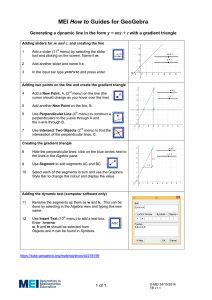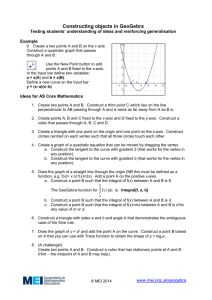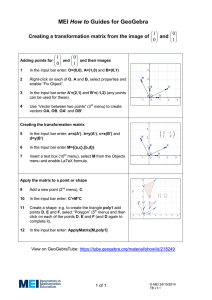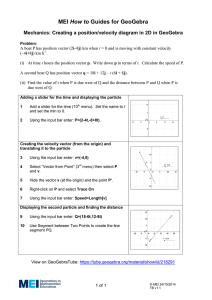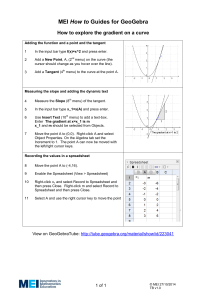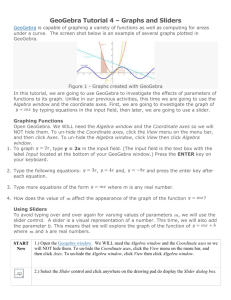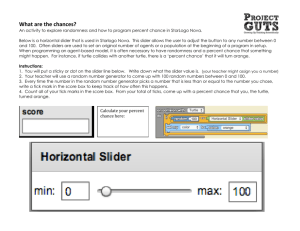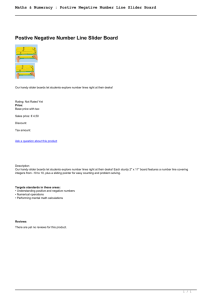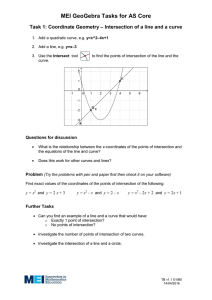MEI GeoGebra Tasks for GCSE Mathematics Algebra 1 y
advertisement
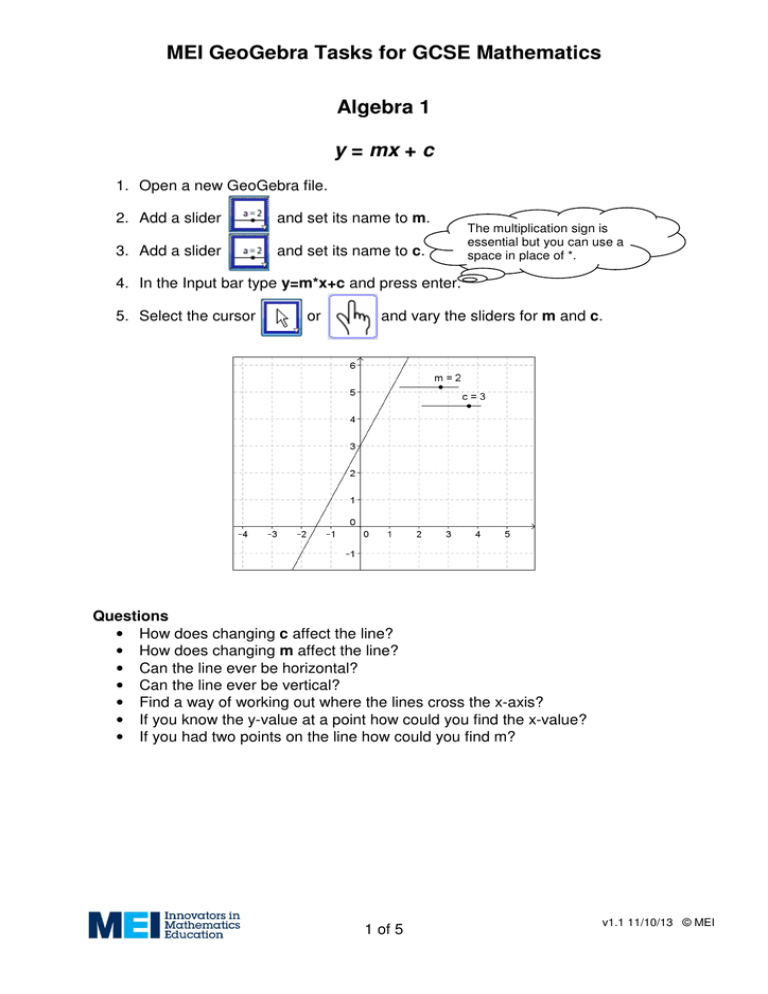
MEI GeoGebra Tasks for GCSE Mathematics Algebra 1 y = mx + c 1. Open a new GeoGebra file. 2. Add a slider and set its name to m. 3. Add a slider and set its name to c. The multiplication sign is essential but you can use a space in place of *. 4. In the Input bar type y=m*x+c and press enter. 5. Select the cursor or and vary the sliders for m and c. Questions • How does changing c affect the line? • How does changing m affect the line? • Can the line ever be horizontal? • Can the line ever be vertical? • Find a way of working out where the lines cross the x-axis? • If you know the y-value at a point how could you find the x-value? • If you had two points on the line how could you find m? 1 of 5 v1.1 11/10/13 © MEI MEI GeoGebra Tasks for GCSE Mathematics Algebra 2 Intersection of two lines 1. Open a new GeoGebra file. 2. Add a slider and set its name to m. 3. Add a slider and set its name to c. 4. In the Input bar type y=m*x+c and press enter. 5. Add a slider and set its name to n. 6. Add a slider and set its name to k. The Intersect Two Objects tool can be found nd on the 2 Menu. Select this tool then click on each line. 7. In the Input bar type y=n*x+k and press enter. 8. Use the Intersect Two Objects tool (2nd menu) intersection of the two lines. 9. Select the cursor or to find the point of and vary the sliders for m, c, n, and k. Questions • How could you find the exact values of the coordinates of the points of intersection from the equations of the lines? • When are the two lines the same? • When will the line and the curve have 0 points of intersection? 2 of 5 v1.1 11/10/13 © MEI MEI GeoGebra Tasks for GCSE Mathematics Algebra 3 Parallel and Perpendicular lines 1. Open a new GeoGebra file. 2. Add a slider and set its name to m. 3. Add a slider and set its name to c. 4. In the Input bar type y=m*x+c and press enter. 5. Add a new point . The Parallel Line tool can th be found on the 4 Menu. Select this tool then click on the point and then the line. NB this point should not be on the line. 6. Use the Parallel Line tool (4th menu) original line through the point. 7. Use the perpendicular line tool (4th menu) the original line through the point. to create a line parallel to the to create a perpendicular to 8. Vary the sliders for m and c and the position of the point. You might find it useful to rewrite the equations of the lines in the form y=mx+c. Questions • What is the relationship between the gradient of parallel lines? • What is the relationship between the gradient of perpendicular lines? • How does this relate to vertical and horizontal lines? 3 of 5 v1.1 11/10/13 © MEI MEI GeoGebra Tasks for GCSE Mathematics Algebra 4 y = x² + bx + c 1. Open a new GeoGebra file. 2. Add a slider and set its name to b. 3. Add a slider and set its name to c. 4. In the Input bar type y=x^2+b*x+c and press enter. 5. Select the cursor or and vary the sliders for b and c. Questions • What is the effect of varying c? • What is the effect of varying b? • Can you find where the curve crosses the x-axis for different values of b and c? • Can you find values of b and c so the curve touches (but doesn’t cross) the x-axis? • Can you find values of b and c so the curve doesn’t cross or touch the x-axis? Extension 6. Add a slider and set its name to a. 7. Change the equation of the curve to y=a*x^2+b*x+c. Question • How does changing a affect the curve? 4 of 5 v1.1 11/10/13 © MEI MEI GeoGebra Tasks for GCSE Mathematics Algebra 5 Factorised form of quadratic equations: y = (x – p)(x – q) 1. Open a new GeoGebra file. 2. Add a slider and set its name to b. 3. Add a slider and set its name to c. The Intersect Two Objects tool can be found nd on the 2 Menu. To find the points click the curve and then the x-axis. 4. In the Input bar type y=x^2+b*x+c and press enter. 5. Use the Intersect Two Objects tool (2nd menu) the curve cuts the x-axis. 6. Select the cursor or to find the points where and vary the sliders for b and c. Questions • Can you find values of b and c so the curve cuts the x-axis at points with integer coordinates? • What is the relationship between b and c the points where the curve cuts the x-axis? • What is the relationship between the points where the curve cuts the x-axis and the point where it cuts the y-axis? • Where is the line of symmetry of the curve? 5 of 5 v1.1 11/10/13 © MEI
